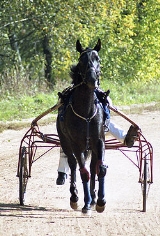
Russian Trotter
Encyclopedia
The Russian Trotter or Métis Trotter was developed in Russia
to create a horse with a faster trotting speed than the older Russian Orlov Trotter
. 156 Standardbred stallions and 220 mares were imported from the United States between the years of 1890 and 1914. Being the fastest trotter in the world, the Standardbred was crossed with the Orlov Trotter
, producing at first animals who were faster but of lower quality. Further breeding produced a larger trotter of better quality. Further infusions of Standardbred and Orlov Trotter were added to the best offspring, and periodic infusions of both breeds are still added to this day.
Breed characteristics had become fixed by 1950, and the breed was officially recognized. Although faster than the Orlov Trotter, it lacks the breed’s refinement and quality, and has conformational defects. The Russians have set certain standards to help improve the overall breed, including a height no less than 15.3 for mares and 16 hh for stallions, a girth of approximately 6 feet and 1 inch, and a bone measurement below the knee of 7.75 inches. The animals are easy to train, quiet, yet energetic when needed.
The Russian Trotter has a plain head, long and muscular neck, and long, sloping shoulders. The chest is wide and deep. The legs are strong with clearly defined tendons, but frequently have a knock-kneed and sickle-hocked conformation, causing the feet to move outward as they move. Although it is technically a defect, it does allow them to more easily lengthen their stride and thus can be an advantage for the racing animals. The pasterns are fairly upright, and the bone is generally too light.
The breed is usually bay in color, but can be chestnut, black or gray. The breed stands between 15.3 and 16 hh.
Russia
Russia or , officially known as both Russia and the Russian Federation , is a country in northern Eurasia. It is a federal semi-presidential republic, comprising 83 federal subjects...
to create a horse with a faster trotting speed than the older Russian Orlov Trotter
Orlov Trotter
The Orlov Trotter is a horse breed with a hereditary fast trot, noted for its outstanding speed and stamina. It is the most famous Russian horse. The breed was developed in Russia in the late 18th century by Count Alexei Orlov at his Khrenovskoy Stud farm near the town of Bobrov...
. 156 Standardbred stallions and 220 mares were imported from the United States between the years of 1890 and 1914. Being the fastest trotter in the world, the Standardbred was crossed with the Orlov Trotter
Orlov Trotter
The Orlov Trotter is a horse breed with a hereditary fast trot, noted for its outstanding speed and stamina. It is the most famous Russian horse. The breed was developed in Russia in the late 18th century by Count Alexei Orlov at his Khrenovskoy Stud farm near the town of Bobrov...
, producing at first animals who were faster but of lower quality. Further breeding produced a larger trotter of better quality. Further infusions of Standardbred and Orlov Trotter were added to the best offspring, and periodic infusions of both breeds are still added to this day.
Breed characteristics had become fixed by 1950, and the breed was officially recognized. Although faster than the Orlov Trotter, it lacks the breed’s refinement and quality, and has conformational defects. The Russians have set certain standards to help improve the overall breed, including a height no less than 15.3 for mares and 16 hh for stallions, a girth of approximately 6 feet and 1 inch, and a bone measurement below the knee of 7.75 inches. The animals are easy to train, quiet, yet energetic when needed.
The Russian Trotter has a plain head, long and muscular neck, and long, sloping shoulders. The chest is wide and deep. The legs are strong with clearly defined tendons, but frequently have a knock-kneed and sickle-hocked conformation, causing the feet to move outward as they move. Although it is technically a defect, it does allow them to more easily lengthen their stride and thus can be an advantage for the racing animals. The pasterns are fairly upright, and the bone is generally too light.
The breed is usually bay in color, but can be chestnut, black or gray. The breed stands between 15.3 and 16 hh.

